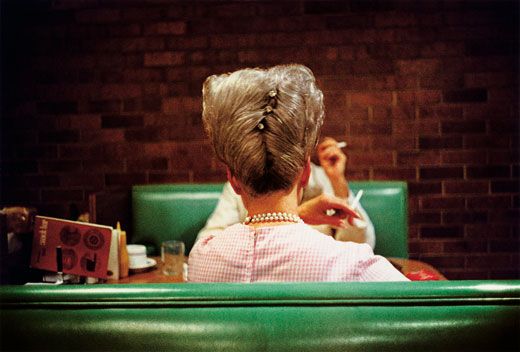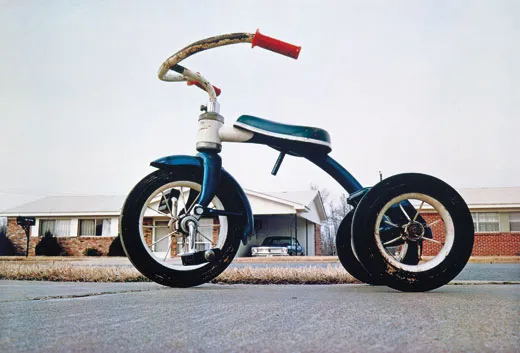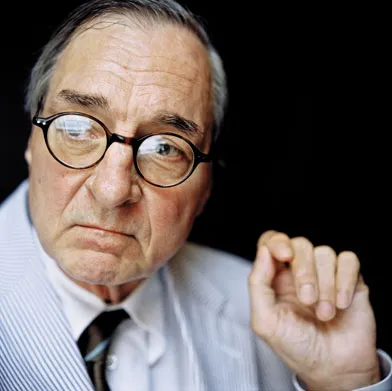William Eggleston’s Big Wheels
This enigmatic 1970 portrait of a tricycle took photography down a whole new road
/https://tf-cmsv2-smithsonianmag-media.s3.amazonaws.com/filer/Indelible-Tricycle-631.jpg)
Although a photograph always shows the same things, that doesn’t mean those things are always seen the same. This William Eggleston picture is variously known as Untitled, Tricycle and Memphis, 1970. It has been variously seen, too. Now considered a classic, it was initially greeted in many quarters with incomprehension, even as an outright affront.
Eggleston’s tricycle first attracted attention as part of a 1976 exhibition of his work at the Museum of Modern Art in New York City. It appeared, in fact, on the cover of the exhibition catalog, William Eggleston’s Guide. “The most hated show of the year,” one critic wrote. “Guide to what?” detractors sniffed about a show whose photographic subjects also included a tiled bathroom wall, the interior of a kitchen stove and the contents of a freezer. Hilton Kramer called Eggleston’s images “perfectly banal” and “perfectly boring.” Kramer, the New York Times’ chief art critic, was playing off of John Szarkowski, MoMA’s director of photography, who had described Eggleston’s photographs as “perfect.” Instead of perfection, Kramer saw “dismal figures inhabiting a commonplace world of little visual interest.”
How well do those words apply to Eggleston’s tricycle? “Dismal” is a subjective judgment. “Commonplace?” Yes, and proudly so. “Of little visual interest”? Well, that’s another story. For starters, Eggleston’s photograph represents a tectonic shift in the medium’s history: the growing acceptance of color in art photography. Tellingly, the MoMA show was the first major solo all-color photography exhibition in the museum’s history. Eggleston was the most prominent member of a cadre of young, talented photographers working in color: Stephen Shore, Joel Meyerowitz, Joel Sternfeld and Eggleston’s fellow Southerner William Christenberry. It was one thing to use color on a fashion model or a sunset. But a tricycle?
Eggleston’s photograph also can be seen in larger cultural terms. In its small way, it’s an example of the growing prominence of white Southern culture in the ’70s—from Richard Nixon’s Southern strategy to the popularity of rock bands like the Allman Brothers and Lynyrd Skynyrd to the election of Jimmy Carter in the same year as the MoMA show. Then there’s a further, literary dimension. As the curator Walter Hopps wrote in an essay for a book following Eggleston’s 1998 Hasselblad Award, his “photographs carry the enriched reverberations of fiction.” This rather forlorn-looking child’s toy (notice the rusted handlebars) is a visual correlative for the ways banality was being used in the short stories of such contemporary writers as Ann Beattie and, especially, Raymond Carver.
Yet the best argument for the tricycle’s visual interest isn’t its place in photographic history or its Southern prov-enance or its affinity with literary “dirty realism.” It’s the photograph itself.
Homely objects had a long tradition of being photographed—but they were finely wrought homely objects, as in the portfolio of hand tools Walker Evans made for Fortune magazine in 1955. Eggleston’s tricycle is different. It’s at once beneath homeliness yet oddly exalted. One way Eggleston achieves this effect is obvious: he shoots the tricycle from a low angle. It looms large in the imagination because it looms large, period. Looking heavenward, Eggleston’s camera bestows on that tricycle the majesty—and ineffability—of an archangel’s throne.
The tricycle does not stand alone. You also find two ranch houses and a car in a carport. You have a patch of dead grass, some asphalt, the sweep of gray sky. The scene is all very, well, negligible. Or is it? The grass and asphalt almost eerily mirror the sky as neutral space. The trike is shot in such a way as to dominate the foreground, like a chariot of very youthful gods. Archangels, deities: for Eggleston, the profane is what’s sacred. Has anyone ever evoked the enchantment of the banal quite so well? “I am at war with the obvious,” he has said.
The tricycle’s many curves mock the angularity of the roofs to the rear. Then there’s the chromatic play of red handle grips with bluish-green seat and frame, not forgetting the several bits of white on seat, frame, stem and wheel rims—the whiteness playing off the roofs and trim of the houses. Color is absolutely not an afterthought. Eggleston started out as a black-and-white photographer—a good one, too, inspired in part by Henri Cartier-Bresson. The point is, Eggleston embraced color photography consciously, aware of how much a richer palette would bring to his art. Remove color, and you severely diminish the effect. The whole thing is a model of unobtrusive artistry amid the everyday nondescript. It seems so simple and artless. Looked at closely, though, it’s as cunning as a seduction, as ordered as a sonnet.
How to account for such a miracle of seeing and recording? Eggleston, now 72, has long declined to discuss the whys and wherefores of specific photographs. Reiner Holzemer’s 2008 documentary film, William Eggleston: Photographer, includes a black-and-white family snapshot. It shows a very young Eggleston in the foreground, looking natty in cap and sailor suit, a tricycle behind him. Might it be a sidewalk-worthy equivalent of Charles Foster Kane’s Rosebud? Surely, not even Eggleston can say. In such indeterminacy begins the mystery and wonder of art, three-wheeled and otherwise.
Mark Feeney, a Boston Globe writer, won a Pulitzer Prize for criticism in 2008.


